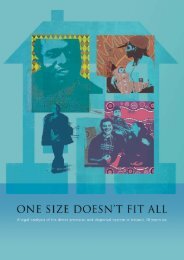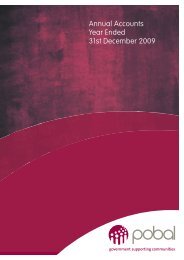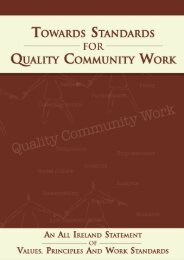Intercultural Education in the Post-Primary School - National Council ...
Intercultural Education in the Post-Primary School - National Council ...
Intercultural Education in the Post-Primary School - National Council ...
Create successful ePaper yourself
Turn your PDF publications into a flip-book with our unique Google optimized e-Paper software.
Action plann<strong>in</strong>gThe school may choose to respond to <strong>the</strong>need to develop an <strong>in</strong>tercultural schoolculture by beg<strong>in</strong>n<strong>in</strong>g with an action planmodel as used <strong>in</strong> <strong>the</strong> <strong>School</strong> DevelopmentPlann<strong>in</strong>g Support materials (detailsavailable on www.sdpi.ie). The action planis a work<strong>in</strong>g document that describes andsummarises what needs to be done toimplement and evaluate a priority. It servesas a guide to implementation and helps tomonitor progress and success. Theadvantages of us<strong>in</strong>g <strong>the</strong> action plan as atool for a whole school approach are thatrepresentatives of <strong>the</strong> whole schoolcommunity may be <strong>in</strong>volved <strong>in</strong> differentelements of <strong>the</strong> process. The school canwork on a number of areas at <strong>the</strong> one timeas different groups can work on a varietyof tasks, and <strong>the</strong> plan can focus on mak<strong>in</strong>gsome th<strong>in</strong>gs happen quickly. Some schoolsmay have had <strong>the</strong>ir own action plans <strong>in</strong>place already and <strong>the</strong>refore may be readyfor a broader plann<strong>in</strong>g approach.Some of <strong>the</strong> key components of <strong>the</strong> actionplan are• outl<strong>in</strong><strong>in</strong>g <strong>the</strong> roles and responsibilities of<strong>the</strong> various personnel <strong>in</strong> relation to <strong>the</strong>actions• identify<strong>in</strong>g <strong>the</strong> resources needed• sett<strong>in</strong>g targets and success criteria• specify<strong>in</strong>g a timeframe• putt<strong>in</strong>g <strong>in</strong> place procedures formonitor<strong>in</strong>g and evaluation.Implement<strong>in</strong>g <strong>the</strong> action planHav<strong>in</strong>g developed an action plan, <strong>the</strong>members of <strong>the</strong> school community willengage <strong>in</strong> <strong>the</strong> process of implementation.The identification of roles, targets, successcriteria and a timeframe, through <strong>the</strong>action plan model, will facilitate <strong>the</strong> school<strong>in</strong> turn<strong>in</strong>g policies <strong>in</strong>to practice. In <strong>the</strong>implementation phase, not all actions willhappen simultaneously. Areas identified aspriority may be dealt with first, with <strong>the</strong>school culture becom<strong>in</strong>g <strong>in</strong>creas<strong>in</strong>gly<strong>in</strong>tercultural as work <strong>in</strong> <strong>the</strong>se areasprogresses and o<strong>the</strong>r areas of <strong>in</strong>terculturalwork are focused on. It may happen that<strong>in</strong> <strong>the</strong> course of <strong>the</strong> implementation newissues arise and require attention.Implementation must, <strong>the</strong>refore, be flexibleto respond to chang<strong>in</strong>g circumstanceswhile rema<strong>in</strong><strong>in</strong>g true to <strong>the</strong> mission andpolicies that <strong>in</strong>corporate <strong>the</strong> school’s<strong>in</strong>tercultural perspective.Monitor<strong>in</strong>g and evaluat<strong>in</strong>g <strong>the</strong> schoolaction planThe plan should <strong>in</strong>clude a procedure formonitor<strong>in</strong>g, review and evaluation by agiven date. Successful implementationshould contribute towards• promot<strong>in</strong>g greater awareness of<strong>in</strong>terculturalism;• help<strong>in</strong>g all students to achieve <strong>the</strong>irpotential;• promot<strong>in</strong>g a supportive and <strong>in</strong>clusivelearn<strong>in</strong>g environment which will foster<strong>the</strong> development of <strong>the</strong> self-esteem of allstudents;• break<strong>in</strong>g down of stereotypes andcelebrat<strong>in</strong>g diversity.As <strong>the</strong> school plann<strong>in</strong>g process is cyclical,this evaluation will <strong>in</strong>form a fur<strong>the</strong>r phaseof review, plann<strong>in</strong>g and implementation.Us<strong>in</strong>g a school development plann<strong>in</strong>g modelto develop a physical and social schoolenvironment <strong>in</strong>clusive of all learnersImportant messages are conveyed to allthose who enter <strong>the</strong> school, whe<strong>the</strong>r asteacher, visitor, parent or student, by <strong>the</strong>physical and social environment of <strong>the</strong>school. This environment <strong>in</strong>cludes <strong>the</strong>learn<strong>in</strong>g experience <strong>in</strong> <strong>in</strong>dividualclassrooms (see Chapter 4), <strong>the</strong> visual28<strong>Intercultural</strong> <strong>Education</strong> <strong>in</strong> <strong>the</strong> <strong>Post</strong>-<strong>Primary</strong> <strong>School</strong>
















